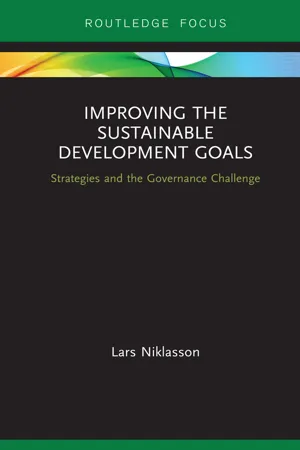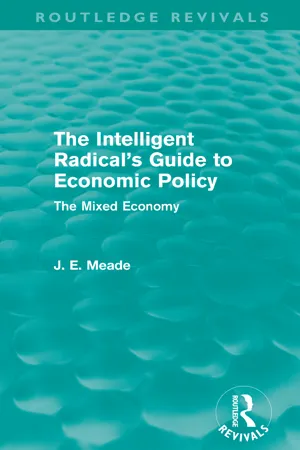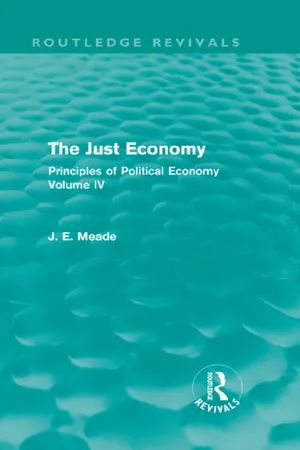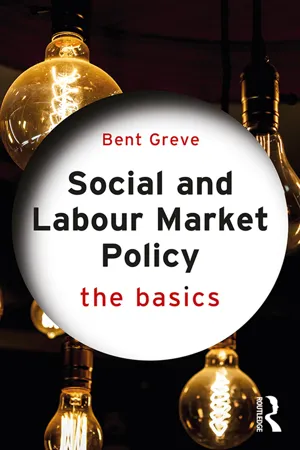Economic and Social Goals
Economic and social goals refer to the desired outcomes that a society aims to achieve through its economic policies and activities. Economic goals typically include factors such as economic growth, full employment, price stability, and efficient allocation of resources. Social goals encompass aspects like reducing poverty, promoting equality, improving living standards, and enhancing overall well-being within a society.
5 Key excerpts on "Economic and Social Goals"
- eBook - ePub
Improving the Sustainable Development Goals
Strategies and the Governance Challenge
- Lars Niklasson(Author)
- 2019(Publication Date)
- Routledge(Publisher)
...A main problem is to find the financial means to pay for social services and basic investments. At the same time, the social goals include means to achieve some of the economic goals – for example, in the form of education and skills development (“human capital”) needed for advanced production. Economic growth is a way to create resources which can be used to pay for education and health care, etc. Several goals talk about resource mobilization, but the more specific issue of domestic taxes is almost not addressed at all. It is most explicitly stated in goal 17 (below). The environmental dimension There are four goals which relate to traditional environmental concerns: goals 12–15. There are links from some of the other goals to environmental issues, as indicated earlier. I will come back to how these goals relate to the Economic and Social Goals, if the environmental goals are limits on the others and if the others contribute to or hinder the fulfilment of the environmental goals. Goal 12: responsible production and consumption The aim of goal 12 is to “ensure sustainable consumption and production patterns”. It is a bridge between the economic and environmental issues. It formulates key aspects of sustainable development by placing limitations on consumption and production, which are the two fundamental dimensions of the economy. Target 12.1 states the general goal of working with these issues and asks the developed countries to take the lead, “taking into account the development and capabilities of developing countries”. Target 12.2 specifies what this should lead to – i.e. to “achieve the sustainable management and efficient use of natural resources”. The following targets add goals on waste management (target 12.3), waste generation (target 12.5) and a concern with “environmentally sound management of chemicals and all wastes” (target 12.4)...
- eBook - ePub
Public Economics
A Concise Introduction
- José Luis Gómez-Barroso(Author)
- 2021(Publication Date)
- Routledge(Publisher)
...3 OBJECTIVES OF STATE ECONOMIC ACTIVITY DOI: 10.4324/9781003173731-3 1 Introduction: types of objectives At the end of the fiscal year, the ministers of economy of every country present their government’s objectives for the following year. These objectives are specified in macroeconomic forecasts of the economy. The indicators on which these forecasts are based make the headlines every month or trimester, whenever the statistics offices publish data about their actual evolution during that period. In this state of affairs, everyone runs the risk of being convinced of how important it is for the country for the GDP to grow or to contain inflation. But it is not. What is important for a society is (or should be) the welfare of its members (all of them) and maintaining the values that sustain the existence of the society itself. These aims cannot be achieved separately from the economy, because the economy is an integral part of social life. Therefore, these are also (or should be) the main or ultimate objectives of public activity in the economy. However, these objectives are hard to get a handle on, because they are vague. “Welfare” or “values” are concepts that are difficult to define and impossible to measure, so they must be clarified by using other variables. This is where all the indicators elaborated by national statistics offices come into play. Such indicators are quantitative, so their evolution can be studied and compared to that of other countries’ indicators. These are derived objectives. These derived objectives do not appear, however, on the list of goals prepared by those in charge of monitoring or correcting specific areas of economic activity. Their job is not to achieve GDP growth but rather, for example, to ensure that the rights of financial services clients are respected. These third level objectives are referred to as immediate objectives...
- eBook - ePub
- James E. Meade(Author)
- 2012(Publication Date)
- Routledge(Publisher)
...I The Objectives of Economic Policy There are many social objectives which all reasonable citizens share in common : a decent standard of living, a decent distribution of income and wealth, individual liberty, individual security, individual participation in the making of decisions. Disagreement starts when these objectives conflict – when, for example, economic efficiency and a consequential high average standard of living is found to be dependent upon a less equal distribution of income and wealth than would otherwise be desirable. The radical in politics is the citizen who places a rather high relative value upon Liberty and Equality in the catalogue of social goods. The intelligent radical does not ignore the other objectives of policy. He, 1 like others, will be much concerned with the encouragement of economic efficiency and with individual security and participation in decision-making. But above all he will dislike policies which lead to large concentrations of power which threaten personal independence, or to large concentrations of income and wealth which perpetuate class distinctions. To achieve the radical’s objectives a great shift of emphasis in present economic policies and institutions is needed in countries such as the United Kingdom. A basic reform which the intelligent radical will support is the restoration and development of the free market mechanism where-ever it is possible to ensure workable competitive conditions. The great virtue of the competitive market mechanism is that it combines efficiency with freedom...
- eBook - ePub
The Just Economy
Principles of Political Economy Volume IV
- James E. Meade(Author)
- 2012(Publication Date)
- Routledge(Publisher)
...These items deal with the possibility of improving the allocation of economic resources either by a more accurate determination of the real social costs and benefits of the various economic activities which are already being conducted (item 6) or else by the selection of a better structure of activities (item 7). In this volume, The Just Economy, we shall be dealing with the set of problems (3), (4) and (5) and we shall leave to a subsequent volume on The Efficient Economy the set of problems (6) and (7). This distinction is a convenient and useful one made only because one cannot discuss everything at once. But, alas, in fact the choice of economic policies makes up a single coherent problem; and in Chapter III we shall consider at some length the difficulties encountered in separating the problem of prosperity or efficiency from that of justice or distribution — that is to say, the problem of what affects the size of the cake from the problem of what affects its distribution. In fact all that we can do is to discuss in this volume the effects of certain factors on the distribution of income and wealth with some side references to their effects on efficiency and in the next volume to discuss the effects of certain factors on economic efficiency with certain side references to their effects on distribution. But the matter is more complicated than that. Prosperity and justice are not the only two basic social goods which may be affected by various economic policies. Equality of opportunity, personal freedom, security and participation in the making of decisions which affect one's life: these are all things which citizens may value and which may be much affected by the choice of economic policies and institutions. Many clashes between these various social objectives can occur. Three examples must suffice to make the point. (1) Suppose that complete equality of incomes were considered to be the most desirable arrangement on purely distributional grounds...
- eBook - ePub
Social and Labour Market Policy
The Basics
- Bent Greve(Author)
- 2018(Publication Date)
- Routledge(Publisher)
...3 Aims of social policy 3.1. Introduction In this third chapter, the focus is on the possible aim of social policy. Historically, the focus was on ensuring basic needs, such as food and shelter. Later on, alleviating poverty came into focus. Today, this is not the only focus; well-being and welfare in a broader sense are also central to social policy. If a central aim is the enhancement of well-being (or welfare), the question is then what is important to look into in order to understand well-being. Further, whether it is possible and whether there are different ways to measure well-being, and what policy recommendation that can lead to. However, this is not sufficient knowledge if one wants to change policy; in that case, one will also have to understand how different instruments might help in the development of well-being; for example, what is the impact of spending on policies to increased well-being, who pays the taxes to finance the welfare, etc.? This chapter also includes, albeit briefly, a presentation of the differences between diverse welfare states types and examples of instruments used. The different means used to achieve the aims of the old and new social risks are presented as they sometimes use different instruments, but also explain why there is constant pressure for change in the structure and approach to social policy. Alleviating poverty and inequality can also be seen, as indicated previously, a possible aim of social policy. Therefore, it is important to know how to measure the different approaches that can be used to change poverty and equality (see the discussion in Section 3.5). It is contested how strong state intervention shall be in order to reduce the number of people at risk of living in poverty, and what the level of inequality shall be. Nevertheless, it is central to understand the mechanism and approaches hereto. 3.2...




